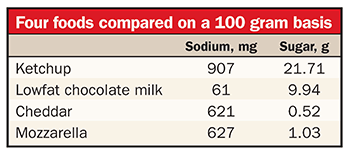We recently heard a presentation from a nutritionist in one of America's largest school districts who was struggling to comply with USDA's school cafeteria requirements. After listening to her discuss nutrition standards for school breakfast and lunch programs, it appears the government's food police have two things in common with the bureaucratic-based Internal Revenue Service - there are more hard-line rules than common sense and regulators are arbitrarily picking winners and losers. To prove our point, let's compare two dairy products, milk and cheese, to ketchup.
To most children, ketchup is a food group in and of itself. Ketchup makes a whole host of foods easier to swallow and perhaps that situation has shielded it from reformulation. However, when comparing the red condiment's nutrition profile to dairy products, it brings little to the lunchroom table.
Let's make an apples-to-apples comparison between the products on the same scale: nutrition per 100 grams. When looking at ketchup, it contributes more sodium than cheese and more sugar than chocolate milk. Yet, there is little public outcry to reformulate ketchup even though it may be a significant contributor to childhood obesity (sugar) and our nation's issues with cardiovascular disease (sodium). Meanwhile, chocolate milk and cheese continue to be scrutinized by the nutrition police.
We have nothing against the red sauce that gets poured on nearly everything. However, we suspect some food and nutrition do-gooders have spent far more energy to reformulate animal-based products in an effort to move them off the food line rather than to improve the nutritional profile of a rather benign vegetable condiment eaten every day.
If school food programs deserve further scrutiny, every food offering should go under the microscope. That includes ketchup. Ketchup adds twice as much sugar as chocolate milk while contributing one-third more sodium than cheese. Those two nutrients are not in short supply on children's plates. However, calcium, potassium and Vitamin D are low in children's diets. Dairy delivers all three.

This editorial appears on page 450 of the July 2014 issue of Hoard's Dairyman.
To most children, ketchup is a food group in and of itself. Ketchup makes a whole host of foods easier to swallow and perhaps that situation has shielded it from reformulation. However, when comparing the red condiment's nutrition profile to dairy products, it brings little to the lunchroom table.
Let's make an apples-to-apples comparison between the products on the same scale: nutrition per 100 grams. When looking at ketchup, it contributes more sodium than cheese and more sugar than chocolate milk. Yet, there is little public outcry to reformulate ketchup even though it may be a significant contributor to childhood obesity (sugar) and our nation's issues with cardiovascular disease (sodium). Meanwhile, chocolate milk and cheese continue to be scrutinized by the nutrition police.
We have nothing against the red sauce that gets poured on nearly everything. However, we suspect some food and nutrition do-gooders have spent far more energy to reformulate animal-based products in an effort to move them off the food line rather than to improve the nutritional profile of a rather benign vegetable condiment eaten every day.
If school food programs deserve further scrutiny, every food offering should go under the microscope. That includes ketchup. Ketchup adds twice as much sugar as chocolate milk while contributing one-third more sodium than cheese. Those two nutrients are not in short supply on children's plates. However, calcium, potassium and Vitamin D are low in children's diets. Dairy delivers all three.










